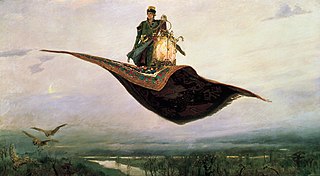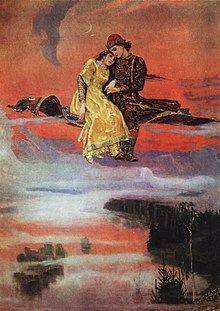Flying carpet

(painting by Wiktor M. Wasnezow ; 1880;
example of other than oriental fairy tales with a flying carpet, namely here Ivan Tsarevich is traveling )
A magic carpet is a mythical means of transport that in Europe is mainly associated with oriental fairy tales, especially the stories from the Arabian Nights . In the imagination it is usually an oriental or Persian carpet .
Flying carpets in a thousand and one nights
Contrary to popular belief, only a few flying carpets appear in the stories from the Arabian Nights . In the Galland manuscript, the oldest manuscript of the Arabian Nights, which includes the first 282 nights, these are e.g. B. not mentioned at all. Nevertheless, some supernatural flying devices appear in the expanded narrative complex, for example in the translation by Gustav Weil .
Aladin and the magic lamp
In this story, Aladin has the princess Bedrulbudur kidnapped on her wedding night together with her bridegroom in bed and brought back the next morning. The bed is carried through the air by the spirit of the lamp. ( Lit .: Weil, 1865) A magic carpet does not originally appear in this version, but it does appear in numerous adaptations such as B. in the 1992 Disney cartoon Aladdin .
The history of the brass city
In this story it is reported that God commanded the wind to wear a carpet for King Solomon "for one month on the way there and the same length on the return journey." According to the description, the carpet was so large that Solomon could assemble an entire army on it:
- “ He immediately collected people and ghosts and birds and wild animals, then ordered the lion, the king of four-footed animals, to gather all the wild animals from the deserts and wastelands. He then called the eagle, the king of birds, and ordered him to merge all the birds of prey. He gave the order to his vizier Damuriat to summon all geniuses and devils and unruly spirits, and Asaf, the son of Berahja, he commissioned to bring together all human troops. When everything was settled in innumerable numbers, Solomon sat down with his troops on his carpet; the birds flew over him and the men and geniuses passed before him. [...] He himself was floating in the air on his wind-blown carpet. "( Lit .: Weil, 1865)
The story of Prince Ahmed and the fairy Pari Banu
The magic carpet in this story is a universal means of transport that can be used by any of its owners, but it does not fly, but teleports itself to their destination with the people who sit on it:
- “ They both sat on it and no sooner had the prince expressed the wish to be transferred to his room in the Chan than both were there, without in the least getting out of their position. "( Lit .: Weil, 1865)
The thief of Baghdad
Abu, who has been given gifts by wise men, asks God for forgiveness and steals the carpet from them to save his friend. The leader of the wise ancients secretly observes the last theft of Abu with a knowing smile, so that the prophecy in the belief of the oppressed people in the Savior (= Abu) may come true.
Contemporary adaptations and entry into pop culture
The magic carpet was already used in the early years of the film : In Paul Leni's silent film The Wax Figure Cabinet (D 1924) this is so convincingly depicted in terms of tricks that Hollywood used this scene for the Douglas Fairbanks film The Thief of Baghdad (USA 1924) shopped.
Also Friedrich Wilhelm Murnau experimented in Faust - a German folk tale (D 1926) flying with a kind of carpet that was actually the cloak of Mephistopheles. Since then, the magic carpet has found its place in countless fairy tale and fantasy films.
In the comic Asterix in the Orient (1987), Asterix, Obelix and Troubadix travel to India on a magic carpet. The carpet is made to fly by the power of a fakir (see levitation ).
In Ralf König's comic Der Zauber des Schabbar (2005, Part 1 by Dschinn Dschinn ), the women's shoe designer Salmonella and his friend, the Ifrit (desert spirit) Schabbar, fly with a flying carpet to the harem of the caliph Harun ar Raschid to kill Salmonella's aunt to bring a love jinn enclosed in an old teapot as a birthday present.
At the beginning of the 1980s , a fair carousel with the name "Flying Carpet" was created, in which the passenger gondola was optically modeled on an oriental carpet and the entire ride was themed in an oriental style. This type of amusement ride can still be found today at folk festivals and amusement parks .
In 1997 Rainald Grebe gave the song "The Billiardaire". In the chorus it says: “I always stayed on the carpet - but my carpet can fly”.
variants
- In the art fairy tale Der kleine Muck by Wilhelm Hauff (1826), the little Muck uses flying slippers .
- In European popular belief, witches can fly on their brooms .
Related topics
- Various military actions carried the code name Flying Carpet , see Operation Magic Carpet .
literature
- Wilhelm Hauff (Ed.): Märchen-Almanach on the year 1826. Metzler, Stuttgart 1826 (Unchanged reprint, with an afterword by Hans-Heino Ewers. Ibid 1991, ISBN 3-476-00755-3 ).
- Gustav Weil : A thousand and one nights. Arabic stories. Neufeld and Henius, Berlin 1865 (reprint of the original edition from 1865, carefully edited. Müller, Erlangen 1984, ISBN 3-86070-308-0 ).
- Kai Meyer : The Storm Kings. 3 volumes. Lübbe, Bergisch Gladbach, 2008–2009.

